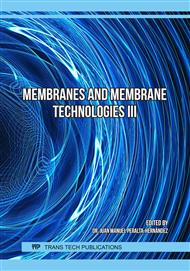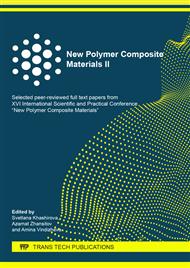[1]
V. Piemonte, M. Maschietti, F.A. Gironi, Triethylene Glycol-Water System: A study of the TEG regeneration processes in natural gas dehydration plants, Energ. Sources Part A. 34 (2012) 456-464.
DOI: 10.1080/15567031003627930
Google Scholar
[2]
H. Lin, S.M. Thompson, A. Serbanescu-Martin, J.G. Wijmans, K.D. Amo, K.A. Lokhandwala, T.C. Merkel, Dehydration of natural gas using membranes. Part I: Composite membranes, J. Membr. Sci. 413 (2012) 70-81.
DOI: 10.1016/j.memsci.2012.04.009
Google Scholar
[3]
P.Yu. Apel, O.V. Bobreshova, A.V. Volkov, V.V. Volkov, V.V. Nikonenko, I.A. Stenina, A.N. Filippov, Yu.P. Yampolskii, A.B. Yaroslavtsev. Prospects of Membrane Science Development, Membr. Membr. Technol. 1 (2019) 45-63.
DOI: 10.1134/s2517751619020021
Google Scholar
[4]
J. Kujawski, A. Rozicka, M. Bryjak, W. Kujawski, Pervaporative removal of acetone, butanol and ethanol from binary and multicomponent aqueous mixtures, Sep. Pur. Technol. 132 (2014) 422-429.
DOI: 10.1016/j.seppur.2014.05.047
Google Scholar
[5]
E.A. Grushevenko, I.A. Podtynnikov, G.S. Golubev, V.V. Volkov, I.L. Borisov, Polyheptylmethylsiloxane – a novel material for removal of oxygenates from water by pervaporation, Petrol. Chem. 58 (2018) 941-948.
DOI: 10.1134/s0965544118110026
Google Scholar
[6]
A. Rozicka, J. Niemistö, R.L. Keiski, W. Kujawski, Apparent and intrinsic properties of commercial PDMS based membranes in pervaporative removal of acetone, butanol and ethanol from binary aqueous mixtures, J. Membr. Sci. 453 (2014) 108-118.
DOI: 10.1016/j.memsci.2013.10.065
Google Scholar
[7]
J.G. Wijmans, A. Ng, A.P. Mairal, Natural gas dehydration apparatus, U.S. Patent No. 7,132,008. (2006).
Google Scholar
[8]
R. Guo, C. Hu, B. Li, Z. Jiang, Pervaporation separation of ethylene glycol/water mixtures through surface crosslinked PVA membranes: coupling effect and separation performance analysis, J. Membr. Sci. 289 (2007) 191-198.
DOI: 10.1016/j.memsci.2006.11.055
Google Scholar
[9]
C. Yu, C. Zhong, Y. Liu, X. Gu, G. Yang, W. Xing, N. Xu, Pervaporation dehydration of ethylene glycol by NaA zeolite membranes, Chem. Eng. Res. Des. 90 (2012) 1372-1380.
DOI: 10.1016/j.cherd.2011.12.003
Google Scholar
[10]
K. Dalane, H.F. Svendsen, M. Hillestad, L. Deng, Membrane contactor for subsea natural gas dehydration: Model development and sensitivity study, J. Membr. Sci. 556 (2018) 263-276.
DOI: 10.1016/j.memsci.2018.03.033
Google Scholar
[11]
G.S. Golubev, I.L. Borisov, V.V. Volkov, Thermopervaporational removal of isopropanol and butanol from aqueous media with using membranes based on hydrophobic polysiloxanes, Petrol. Chem. 58 (2018) 975-982.
DOI: 10.1134/s0965544118110014
Google Scholar
[12]
I.L. Borisov, V.V. Volkov, Thermopervaporation concept for biobutanol recovery: The effect of process parameters, Sep. Pur. Technol. 146 (2015) 33-41.
DOI: 10.1016/j.seppur.2015.03.023
Google Scholar
[13]
G.S. Golubev, I.L. Borisov, V.V. Volkov, A.V. Volkov, High-performance reinforced PTMSP membranes for thermopervaporation removal of alcohols from aqueous media, Membr. Membr. Technol. 2 (2020) 45-53.
DOI: 10.1134/s2517751620010047
Google Scholar
[14]
I.L. Borisov, G.S. Golubev, V.P. Vasilevsky, A.V. Volkov, V.V. Volkov, Novel hybrid process for bio-butanol recovery: Thermopervaporation with porous condenser assisted by phase separation, J. Membr. Sci. 523 (2017) 291-300.
DOI: 10.1016/j.memsci.2016.10.009
Google Scholar
[15]
V. Volkov, I. Borisov, G. Golubev, V. Vasilevsky, D. Matveev, G. Bondarenko, A. Volkov, Sorption-assisted thermopervaporation method for organics recovery from ABE fermentation broth, J. Chem. Technol. Biotechnol. 95 (2020) 40-51.
DOI: 10.1002/jctb.6196
Google Scholar
[16]
A.V. Volkov, E.G. Novitsky, I.L. Borisov, V.P. Vasilevsky, V.V. Volkov, Porous condenser for thermally driven membrane processes: Gravity independent operation, Sep. Pur. Technol. 171 (2016) 191-196.
DOI: 10.1016/j.seppur.2016.07.038
Google Scholar



